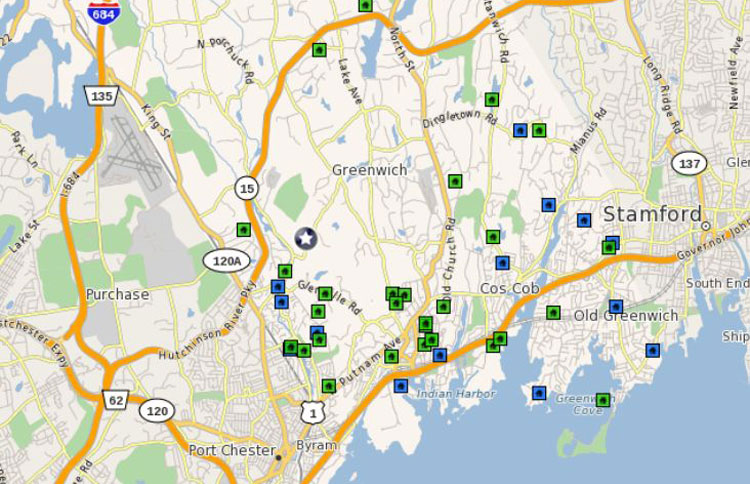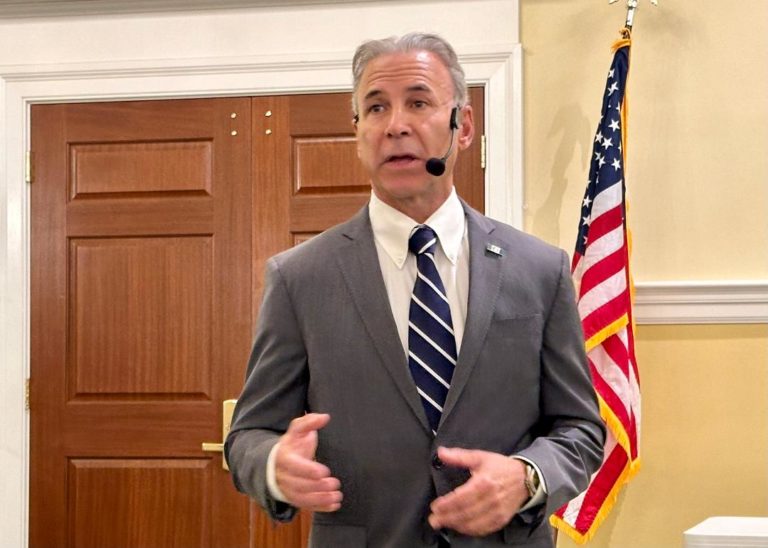
By Allan Murphy
Sentinel Contributor
 Before we get to brokerage and football, a quick aside about the ability to rent your own private island right here in Greenwich. A few hardy souls started “lining up” in the town hall parking lot on Monday afternoon beginning about 2 p.m. By 9 p.m. there was a list of 11 names hand-written in black magic marker on a poster board duct-taped to the side of a van in the parking lot. The wind was howling and the ambient temperature about 20 degrees, with a forecasted overnight low of 14. And very windy. In order to hold your place on the list you have to stay there—all night long.
Before we get to brokerage and football, a quick aside about the ability to rent your own private island right here in Greenwich. A few hardy souls started “lining up” in the town hall parking lot on Monday afternoon beginning about 2 p.m. By 9 p.m. there was a list of 11 names hand-written in black magic marker on a poster board duct-taped to the side of a van in the parking lot. The wind was howling and the ambient temperature about 20 degrees, with a forecasted overnight low of 14. And very windy. In order to hold your place on the list you have to stay there—all night long.
At least one intrepid soul rented a van and set up a sleeping cot in the back. Other folks simply hunkered down beneath sleeping bags and blankets in their cars. The Parks and Recreation office opened at 8 a.m. Tuesday morning to begin taking sign-ups for overnight camping permits for this summer for Island Beach and Great Captains Island. For a few hundred dollars, you can have either island entirely to yourself and up to 15 friends and family (there is a caretaker that lives at Island Beach in the event of an emergency). You do have to camp out and BYO everything, but having done it myself, it’s pretty cool to be out in the middle of Long Island Sound on your own private island for the evening. When the last ferry takes the last day-trippers back to the Arch Street dock and the quiet of the evening settles over the island, it’s a slice of Greenwich paradise. For those who secured a holiday weekend full moon Saturday night—it’s a great value rental, but you deserve it and you earned it!
This season of football playoffs has me thinking about the need for a good quarterback on commercial lease (or sale) transactions. For most tenants, the transaction process occurs only every few years, but when it does occur it’s time-consuming and important, as the economic commitment is substantial and the work environment impacts the entire organization for multiple years. The process should start several months in advance of a lease expiration, and for larger leases, even years in advance (this timing may also be impacted by lease renewal provisions written into the current lease). It’s almost always better to negotiate a mutually acceptable new lease in advance of having to exercise a specific renewal option that may bind either or both parties in ways that could have been better structured outside of the written option.
The process starts with a review of a tenant’s current and future needs for space, including head count, growth expectations, configuration and location of seating and conference/public rooms, overall quality and style of the space and building, geographic location preferences, parking needs, and budget. Once the forgoing needs have been defined, a tenant can then “survey” the market to determine what spaces in what buildings (and at what price points) may be available in a time frame that meets the tenant’s needs.
The next step is to review and compare the possible options. Some spaces may already be built-out with a need for only minor modifications, while other spaces may require complete renovation. We usually recommend adding an architect to the team at this point. Sometimes this is a landlord-provided service, and other times it’s better to have your own dedicated professional that works directly for the tenant, regardless of the building(s) under consideration. The architect provides “test fits” to design the space to fit the tenant’s specific needs and tastes, provides design input for interior finishes, can coordinate furniture vendors if needed, can produce construction specifications and construction drawings if needed, and can oversee the construction process if appropriate. Having the right architect can be an important element in the process, even for seemingly simple projects.
The extent of the needed construction (if any) is important to both the economics and timing of a transaction. Less construction should yield better economics for both the tenant and landlord, and less construction means that the space can be available sooner. This sometimes creates a challenge in comparing spaces or competing for spaces, as the tenant need may be several months away (and needing that time for spaces requiring a build-out), but a landlord may have space that is built and ready to go, and want a tenant that can use the space and start to pay rent right away.
A good transaction “quarterback” will drive the above process (which is just the beginning), assemble the right team, and manage the overall transaction—which still includes economic (and qualitative) comparisons, orchestrating a competitive process, negotiating term sheet and lease provisions, and doing it all super-expeditiously, since we all know that the passage of time will change, or kill, all deals. More on the rest of process in my next column, and in the meantime, go Pats! (I’m originally from Michigan and am therefore a Tom Brady fan, since my Lions can’t seem to get it done. Plus, we do live in New England.)
Allan Murphy is a senior managing director at the commercial real estate services firm Newmark Grubb Knight Frank. He has specialized in the Greenwich and Stamford markets since 1996.




